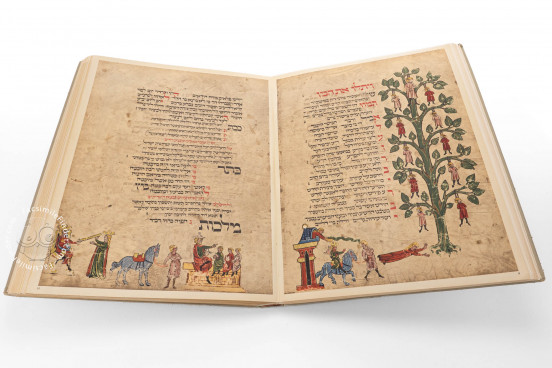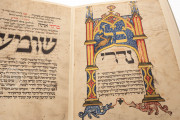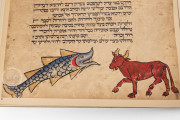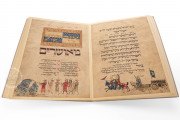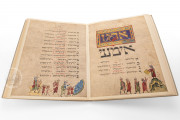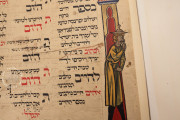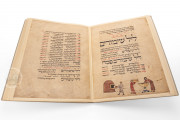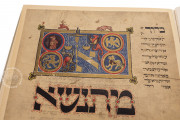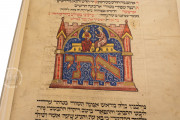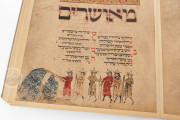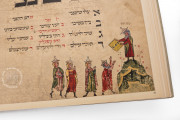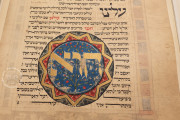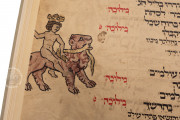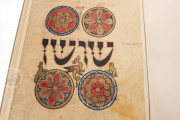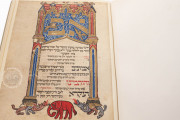The Leipzig Mahzor, produced at the beginning of the fourteenth century, probably in Worms, is an imposing manuscript of prayers and biblical readings for Jewish holidays throughout the year, divided into two volumes. The text is richly illuminated with nineteen vignettes in gold and watercolors, many of which depict narratives relating to the origins of, or preparations for, the feast days.
The Leipzig Mahzor dates back to the early fourteenth century and is widely recognized as a valuable work of Jewish art. Indeed, since of the prayers and poems for Feasts included in the manuscript are no longer in use, the codex is a valuable source of information on the history of synagogue prayer and liturgy. The present division into two volumes is not original, as shown by the fact that the Scroll of Ruth is split between them.
The Artists and Their Illuminations
Each page of the manuscript features illustrations or ornamentation, which were likely not the work of a single artist, with differences noted between the marginal illuminations and the illustrations in the text. Moreover, the miniatures in the first and second volumes differ significantly. The scribes and illuminators of both volumes are unknown, except for the punctuator, Joseph Nakdan.
The abundant use of number symbolism in the borders of the miniatures and elsewhere is noteworthy. The majority of the miniatures, as well as the large square lettering beneath them, are adorned with studs placed by the illuminators for a specific purpose. This is evident in the fact that the number of studs used to embellish a particular letter or miniature corresponds to the numerical value of the letters themselves. The influence of cabalistic tendencies can be observed in this practice, as it is unlikely that the choice of numbers was based on mere whim, and the artists would have been familiar with such practices.
The numerous illustrations and illuminations in the Leipzig Mahzor suggest that Jewish book illustration was well-established in Germany by the mid-fourteenth century and influenced by local traditions. The pigments used in the illustrations reflect typical German miniature painting of the time, with the predominant heraldic colors being red, blue, green, black, gold, silver, and purple. Despite this influence, the decoration's content and feeling are distinctly Jewish. The Leipzig Mahzor initially contained catchwords on every page, but cropping during rebinding caused the loss of many of them, resulting in the damage of some illustrations.
Harmony Between Script and Illustrations
The manuscript is written in a square Ashkenazi script, with each leaf ruled on both sides, containing twenty-seven horizontal lines enclosed by vertical margins. The script was carefully executed and complements the illustrations. Various glossators wrote numerous later corrections and marginalia in different inks and scripts, which are mostly grammatical and textual.
We have 1 facsimile edition of the manuscript "Leipzig Mahzor": Machsor Lipsiae facsimile edition, published by Edition Leipzig, 1964
Request Info / Price
